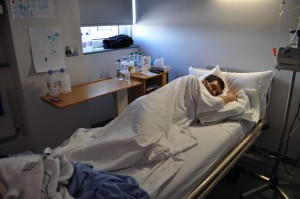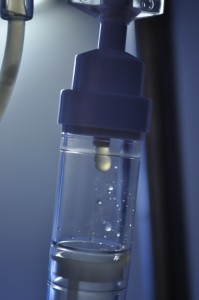Edumacation
Since B isn’t here right now (I just missed him, he headed down for his ‘scope as I was walking in), and we’ve had a few questions, it’s class time! Sharpen your pencils now.
There’s been a few questions about the numbers that I’m posting, the WBC, hemoglobin, and platelets.
Let’s start from the beginning: leukemia. Broken down, the origins of the word are leuk (white) and emia (substance in the blood). White blood, aka large amounts of white blood cells in the blood.
WBC, the acronym I’ve used for white blood cells, are the main marker that B had leukemia. Normal levels would be 4,500-10,000 white blood cells per microliter (mcL), which we have been shortening to 4.5-10. When B was diagnosed, his white cell count was 100, or 100,000 white blood cells per mcL. That with the headaches, the bruising, the exhaustion and the *low* red blood cell count (exhaustion and low red blood cell counts go hand in hand, as that means anemia) are all symptoms of leukemia.
Right now, B’s white blood cell count is 0.3. This is good, because the chemo is doing what it is supposed to do, kill off the cancer cells. But since chemo isn’t selective, it kills off the fast-growing cells in your body: the cancer, blood, and hair cells. Hence why people end up losing their hair, and being super sensitive to fabrics, the labels and seams of their clothes. So the chemo is also killing off the white blood cells. Why is this good? Because the cancer cells “don’t do the work of normal white blood cells, they grow faster than normal cells, and they don’t stop growing when they should.”
Again, since chemo isn’t selective, it’s also killing off the red blood cells. Inside the red blood cells are hemoglobin protein, which carries the oxygen from our lungs all around our bodies and is iron rich. It’s part of the reason we have pink cheeks! All that lovely red blood keeps us going. If you are lacking in red blood cells, you become anemic, which isn’t good. So they are infusing B with “clean” blood from donors, to get his red blood cells back up and keep him healthy that way. Men should have a normal red blood cell count of 4.7 to 6.1 million/uL. So when I say 8.8, I mean 8.8 million.
Platelets, I’ve learned, are kewl. They are one of the keys to your blood clotting. The reason they’re called platelets are they look a bit like a plate, where they are roundish, more jelly doughnut like, but more squooshed in the middle. When they bump into each other, and their outer “skin” is ruptured, they turn more into an octopus looking cell, and clump together. There’s how your cuts stop bleeding! Platelets are effected by the chemo too, so to make sure he has enough and to make sure his blood clots where and when it needs to (see, his eyes thing is because he was low on platelets and there was minor hemmorhaging). So today he got extra platelets because he was having the ‘scope, and they wanted to minimize the chance of any bleeding. Normal platelet counts are 150,000-450,000 per μl (microlitre) of blood, which we’ve been saying as 15-45 for the count. The bags of platelets are neat looking, btw. It reminds me of cold honey…you know when it’s crystallized slightly? And sorta thick? That’s what it looks like in the bag to me.
One interesting thing about platelets: once a woman has been pregnant, she cannot donate platelets. There are antibodies that are created when pregnant that stay in your body, and once you have ’em, no more donating. The largest group of donors are, obviously, men. And you can specifically donate platelets…so please do.
Those are the important numbers, really. And, again, I know there’s a few oncology nurses reading this now, so please correct me if I’m wrong!



